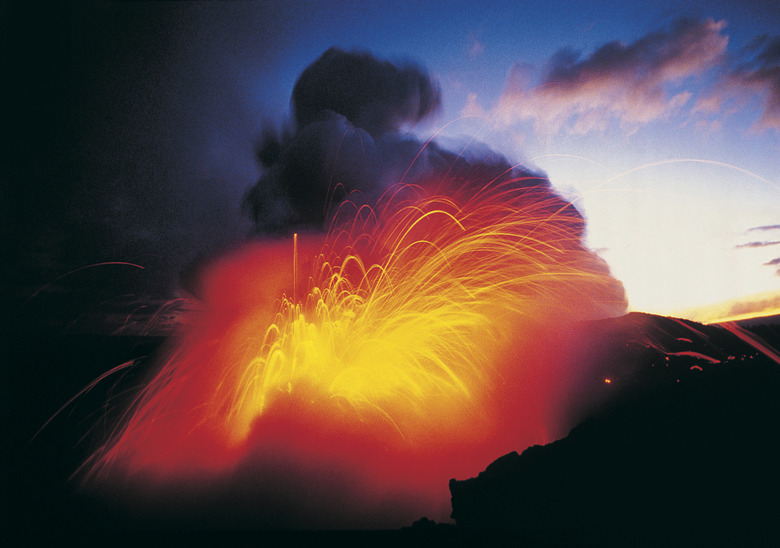What Is The Most Dominant Gas In Volcano Eruptions?
A red hot, flowing river of lava may be a volcano's most dramatic discharge, but a good deal of emissions during an eruption are gases ejected into the atmosphere. A variety of volcanic gases are released with important and sometimes unexpected consequences. Volcanic gases can cause local air pollution, influence weather patterns, deplete the ozone layer and contribute to global warming. Under some circumstances, volcanic gases can also be highly poisonous. The most common gas released during eruptions is water vapor, but each volcano differs in the types and proportions of gases released.
Water Vapor
Water Vapor
Superheated water vapor is the most common gas released during volcanic eruptions. Water vapor can account for 97 percent or more of total gas emissions from a volcano, but can also be a relatively minor discharge in some volcanoes. As volcanic magma — molten rock — rises to the surface, the pressure on the magma is reduced. Under these conditions, water vapor expands in volume, often with explosive force. According to the Volcano Hazards Program of the U.S. Geological Survey, the rapid expansion of water vapor is one of the primary forces that contribute to volcanic explosions.
Carbon Dioxide
Carbon Dioxide
Carbon dioxide is the second most abundant gas released from volcanic eruptions. According to USGS data, it can range from around one percent to almost 50 percent of total volcanic gases. Although carbon dioxide is one of the primary gases contributing to global climate change, scientists have calculated that total volcanic emissions of carbon dioxide are much smaller than emissions of human origin, and are not large enough to make a noticeable contribution to global warming. Although volcanic carbon dioxide discharges normally dissipate in the atmosphere, they sometimes produce dangerous local concentrations of the gas that can settle in low-lying areas, displacing the air and making the area unbreathable.
Sulfur Dioxide
Sulfur Dioxide
Although sulfur dioxide releases are generally not as large as water vapor or carbon dioxide releases, the impact of this gas is considerable. The local presence of sulfur dioxide emissions from a volcano lead to serious air pollution events, including smog and acid rain. Volcanic sulfur dioxide injected high into the atmosphere from major eruptions can actually affect global climate, since this gas is a very potent global warming chemical. The reactions between sulfur dioxide and other chemicals can also deplete the atmosphere's protective ozone layer.
Other Gases
Other Gases
Other gases released by volcanoes in smaller quantities include hydrogen, hydrochloric acid vapor and hydrogen sulfide, Volcanoes can also release hydrogen fluoride gas. Although released in relatively small amounts, this highly poisonous gas has been known to contaminate plants near the volcano, and these can become toxic to grazing animals.
Cite This Article
MLA
Sarokin, David. "What Is The Most Dominant Gas In Volcano Eruptions?" sciencing.com, https://www.sciencing.com/dominant-gas-volcano-eruptions-12319033/. 24 April 2017.
APA
Sarokin, David. (2017, April 24). What Is The Most Dominant Gas In Volcano Eruptions?. sciencing.com. Retrieved from https://www.sciencing.com/dominant-gas-volcano-eruptions-12319033/
Chicago
Sarokin, David. What Is The Most Dominant Gas In Volcano Eruptions? last modified March 24, 2022. https://www.sciencing.com/dominant-gas-volcano-eruptions-12319033/
